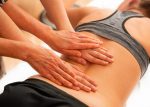Survey Finds Pain, Fatigue Common for Vascular EDS Patients in Norway
Symptoms linked to sleep problems and multi-organ disease burden

Chronic pain and fatigue are common symptoms among people with vascular Ehlers-Danlos syndrome (vEDS) and Loeys-Dietz syndrome (LDS), a Norwegian study has found.
While the symptoms were linked to each other, they were each also associated with the presence of sleep problems and a greater multi-organ disease burden, data show.
“In this study, symptoms of chronic pain, fatigue, sleep problems, and disease burden seemed to mutually reinforce each other,” the researchers wrote.
“Initiatives should consider interventions aimed at postponing the onset and reducing symptoms of pain, fatigue, and sleep problems and thus reduce the total disease burden at an early stage in patients with these complex conditions,” they added.
The study, “Pain and fatigue in adults with Loeys–Dietz syndrome and vascular Ehlers–Danlos syndrome, a questionnaire-based study,” was published in the American Journal of Medical Genetics Part A.
vEDS and LDS are two forms of hereditary thoracic aortic diseases, characterized by increased risks of bulges caused by weakened blood vessel walls (aneurysms) and blood vessel tears (dissections) in the aorta — the artery supplying blood from the heart to the body.
Both affect the body’s connective tissue, which protects, supports, and gives structure to all other tissues and organs in the body.
While many individuals living with chronic diseases such as EDS, including those with Marfan syndrome (another thoracic aortic disease), experience pain and fatigue, knowledge of these symptoms in vEDS and LDS is lacking.
A team of researchers previously found that patients diagnosed with vEDS or LDS in Norway reported a high prevalence of pain and fatigue. The researchers now invited participants from that study to complete an additional questionnaire to gain a deeper understanding of these symptoms in the two conditions.
Overall, 52 of 70 invited participants completed the questionnaires. Among them, 30 were women and the mean age was 42.9. Eighteen participants had vEDS and 34 had LDS.
Pain and fatigue were common symptoms in both groups. Chronic musculoskeletal pain — that affecting the bones, joints, or muscles — was reported by 79% of participants, with 67% of the vEDS group and 85% of the LDS group affected. These rates are significantly higher than that reported in the Norwegian general population (24%), the researchers noted.
“There is no doubt that pain seems to be a problem for a huge proportion of these patients,” they wrote.
While the number of pain areas did not differ by LDS vs. vEDS diagnosis, those with LDS experienced greater self-reported pain intensity while active.
Among the 41 people reporting pain, seven reported it had emerged in childhood, 16 said its onset was in adolescence, and 18 reported onset occurred in adulthood.
Pain was exacerbated for a variety of reasons, including physical activity (56%), inactivity (59%), stress (66%), static work situations (63%), or cold (73%). Many participants said they used some form of pain relief, including heat (61%), painkillers (analgesics; 61%), or cooling (10%).
Participants reported pain in the head, neck, lower back, and knees significantly more often than what was reported in the general population. Many in the vEDS group also reported pain in the upper back and abdomen.
Many respondents experiencing pain said it influenced their participation in leisure activities (32 people), housekeeping (31 people), and work life (26 people).
Overall, those with a greater multi-organ disease burden, greater symptoms of fatigue, and perceived sleep problems were significantly more likely to experience chronic pain.
More than half (58%) of the study participants reported high levels of fatigue, reflected by a score of five or more on the fatigue severity scale. This included eight people with vEDS and 22 with LDS. In comparison, high levels of fatigue have been reported by 23% in the Norwegian general population, the researchers noted.
Low physical activity levels, sleeping problems, chronic musculoskeletal pain, increased anxiety, and high cardiovascular and multi-organ disease burden were each significantly associated with fatigue scores.
Thirty-five people reported sleep problems, including problems falling asleep (69%), sleeping coherently (66%), staying awake during the day (54%), and waking up early (40%).
While sex, age, and educational level have been linked to pain and fatigue in the general population, such associations were not observed among the vEDS and LDS patients.
“We conclude that chronic pain and fatigue symptoms should be recognized as important features among patients with [hereditary thoracic artery diseases] in the lifelong follow-up,” the researchers wrote.
Among the study’s limitations was the low number of participants, which does “not allow for firm conclusions or generalizability to LDS or vEDS patients as such, and need more robust studies for confirmation,” the researchers noted.








